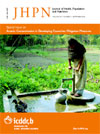
|
The Journal of Health, Population and Nutrition
icddr,b
ISSN: 1606-0997
EISSN: 1606-0997
Vol. 36, No. 1, 2017, pp. 1-12
|
 Bioline Code: hn17039
Bioline Code: hn17039
Full paper language: English
Document type: Research Article
Document available free of charge
|
|
|
The Journal of Health, Population and Nutrition, Vol. 36, No. 1, 2017, pp. 1-12
| en |
Epidemiology of hypertension in Fulani indigenous populations—age, gender and drivers
Nyuyki, Clement Kufe; Ngufor, George; Mbeh, George & Mbanya, Jean Claude
Abstract
Background: Hypertension is a public health problem and the main contributor to cardiovascular mortality and
morbidity. Little is known about hypertension among the minority, diverse and socially disadvantaged 23–24
million Fulani/Peul populations dispersed in West, Central and East Africa, undergoing a transition from traditional
to transitional and modern lifestyle.
This study describes age and gender variations in blood pressure and drivers of hypertension among rural Fulani
population of Cameroon.
Methods: We analysed population-based cross-sectional data collected in 2013 by standard methods from 1337
Fulani/Peul aged ≥ 20 years. Hypertension was defined as systolic blood pressure (SBP) ≥ 140 mmHg and/or
diastolic blood pressure ≥ 90 mmHg or current use of anti-hypertensive medication. We elucidated the occurrence
and drivers of hypertension by chi-square test, Student’s t test and univariate and multivariable logistic regression
models.
Results: The prevalence of hypertension was 31.1% (men 36.5% and women 28.7%). Systolic and diastolic blood
pressure increased with age. Older women suffered more from grades 1, 2 and 3 hypertension than older men. Old
age, divorced/separated, never attended school, current/former smoker, family history (FH) of hypertension, diabetic,
underweight and substantially increased risk from waist circumference were independently associated with
hypertension. Insomnia and had 8–12 children were the only drivers of hypertension among men.
Conclusion: Prevalence of hypertension was high. Awareness and control were low. Hypertension prevalence
increased with age and was more prevalent among men than women. Older women experienced severe
hypertension more than older men. Culturally embedded interventions are warranted to curb the high burden of
hypertension among the Fulani.
Keywords
Epidemiology; Hypertension; Fulani; Blood pressure; Drivers
|
| |
© Copyright 2017 - The Author(s)
Alternative site location: http://www.jhpn.net
|
|
